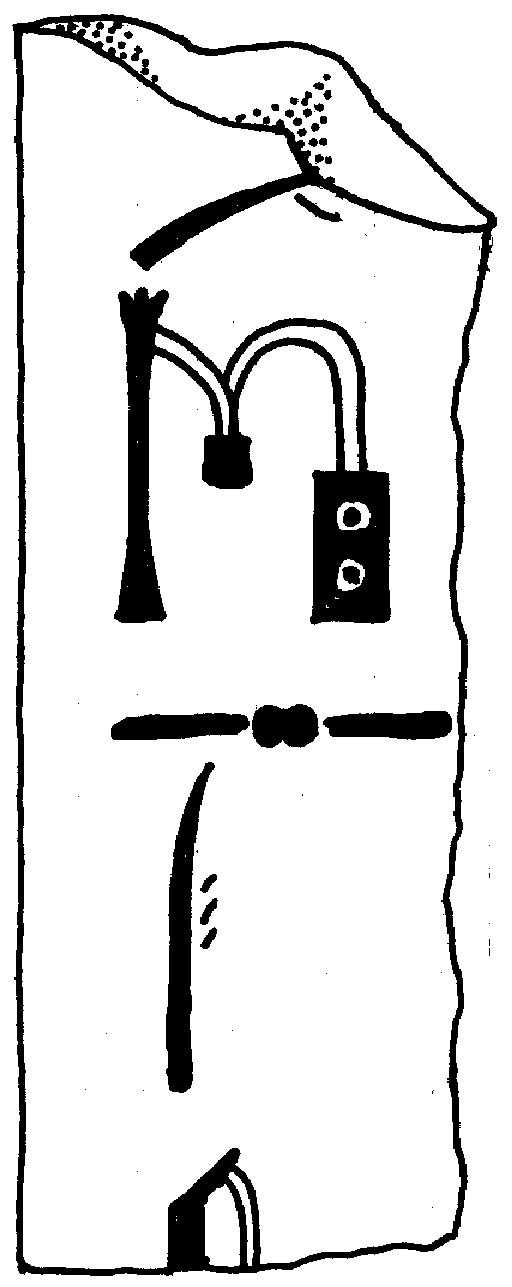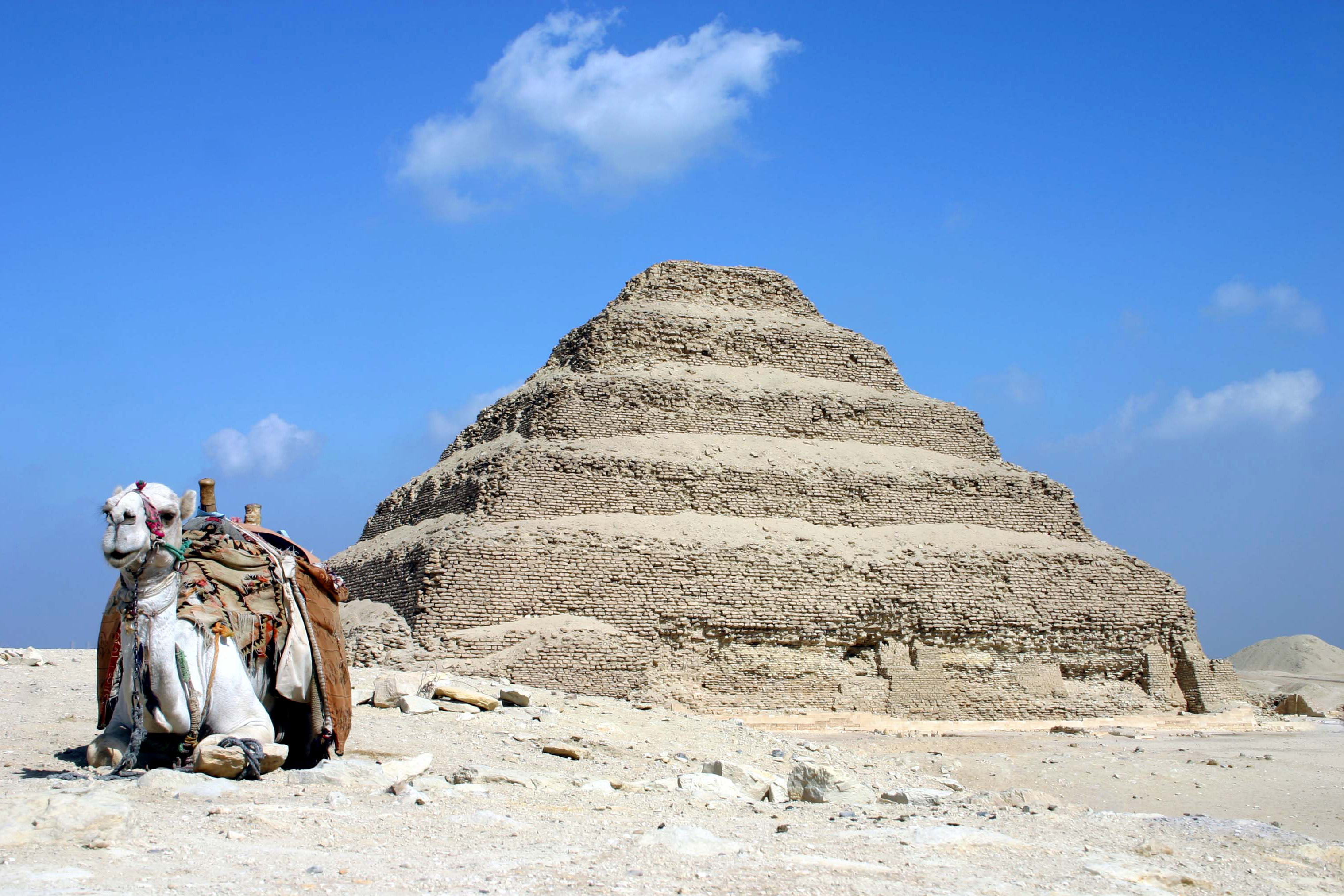|
Mastaba Of Hesy-Re
The Mastaba of Hesy-re is an ancient Egyptian tomb complex in the great necropolis of Saqqara in Egypt. It is the final resting place of the high official Hesy-Ra, who served in office during the Third dynasty of Egypt, Third Dynasty under King Djoser (Netjerikhet). His large mastaba is renowned for its well-preserved wall paintings and relief panels made from imported Lebanese cedar, which are today considered masterpieces of Old Kingdom of Egypt, Old Kingdom wood carving. The mastaba itself is the earliest example of a painted tomb from the Old Kingdom and the only known example from the Third Dynasty. The tomb was excavated by the Egyptologists Auguste Mariette and James Quibell. Discovery and excavation First dig The mastaba of Hesy-re was originally excavated in 1861 by Auguste Mariette and Jacques de Morgan, Jacques Morgan. Mariette quickly discovered the famous niched gallery with its wooden panels and had these valuable artefacts brought to the Egyptian Museum in Cairo. ... [...More Info...] [...Related Items...] OR: [Wikipedia] [Google] [Baidu] |
Hesy-Ra
Hesire (also read Hesy-Re and Hesy-Ra) was an ancient Egyptian high official during the early Third Dynasty of Egypt. His most notable title was ''Wer-ibeḥsenjw'', meaning either "Great one of the ivory cutters" or "Great one of the dentists", which makes him the earliest named dentist. His tomb is noted for its paintings and cedar wood panels. Identity Thanks to several clay seal impressions found in Hesire's tomb, it is today known that this high official lived and worked during the reign of king (pharaoh) Djoser and maybe also under king Sekhemkhet. Hesire's name is of some interest to Egyptologists and historians alike, because it is linked to the sun god Ra. Hesy-Ra, alongside a few high officials at this time, belongs to the first high officials who were allowed to link their names to Ra. However, they were not allowed to use the sun disk hieroglyph to write Ra's name. This was permitted to the king only.Wolfgang Helck: ''Geschichte des alten Ägypten'' (= ''Handbuch ... [...More Info...] [...Related Items...] OR: [Wikipedia] [Google] [Baidu] |
James Quibell
James Edward Quibell (11 November 1867 – 5 June 1935) was a British Egyptologist. Life Quibell was born in Newport, Shropshire. He married the Scottish artist and archaeologist Annie Abernethie Pirie in 1900.Bierbrier, M. L. 2012. ''Who Was Who in Egyptology'' 4th edn. London: Egypt Exploration Society. pp. 450. He was educated at Adams' Grammar School in Newport and Christ Church, Oxford. He became fascinated by the antiquities, and offered himself as a pupil to Professor Flinders Petrie, with whom he worked at Coptos in 1893, then at Nagada, Ballas, Thebes, El Kab, and Hierakonpolis in successive years, including the Ramesseum. He also assisted Cecil Firth in his excavations in Saqqara. Between 1899 and 1904, he also served as chief inspector of antiquities for the Delta and Middle Egypt (Howard Carter, who was chief inspector at Luxor was his opposite). Later, between 1904 and 1905, he was appointed as chief inspector at Saqqara. Between 1914 and 1923, he was a keeper ... [...More Info...] [...Related Items...] OR: [Wikipedia] [Google] [Baidu] |
Pyramid Of Djoser
The pyramid of Djoser, sometimes called the Step Pyramid of Djoser or Step Pyramid of Horus Netjerikhet, is an archaeological site in the Saqqara necropolis, Egypt, northwest of the ruins of Memphis.Bard, Kathryn A., and Jean-Philipee Lauer, eds. 1999. "Saqqara, pyramids of the 3rd Dynasty" ''Encyclopedia of the Archaeology of Ancient Egypt''. London: Routledge. 859 It is the first Egyptian pyramid to be built. The 6-tier, 4-sided structure is the earliest colossal stone building in Egypt. It was built in the 27th century BC during the Third Dynasty for the burial of Pharaoh Djoser. The pyramid is the central feature of a vast mortuary complex in an enormous courtyard surrounded by ceremonial structures and decoration. The pyramid went through several revisions and redevelopments of the original plan. The pyramid originally stood tall, with a base of and was clad in polished white limestone. As of 1997 the step pyramid (or proto-pyramid) was considered to be the earliest ... [...More Info...] [...Related Items...] OR: [Wikipedia] [Google] [Baidu] |
Silhouette
A silhouette (, ) is the image of a person, animal, object or scene represented as a solid shape of a single colour, usually black, with its edges matching the outline of the subject. The interior of a silhouette is featureless, and the silhouette is usually presented on a light background, usually white, or none at all. The silhouette differs from an line art, outline, which depicts the edge of an object in a linear form, while a silhouette appears as a solid shape. Silhouette images may be created in any visual artistic medium, but were first used to describe pieces of cut paper, which were then stuck to a backing in a contrasting colour, and often framed. Cutting portraits, generally in profile, from black card became popular in the mid-18th century, though the term ''silhouette'' was seldom used until the early decades of the 19th century, and the tradition has continued under this name into the 21st century. They represented a cheap but effective alternative to the portrait m ... [...More Info...] [...Related Items...] OR: [Wikipedia] [Google] [Baidu] |
Metjen
Metjen (also read as Methen) was an ancient Egyptian high official at the transition time from Third Dynasty of Egypt, 3rd Dynasty to Fourth Dynasty of Egypt, 4th Dynasty. He is famous for his tomb inscription, which states that he worked and lived under the kings (pharaohs) Huni and Sneferu. Biography Family According to his tomb inscriptions, Metjen was a son of the high official Inpu-em-Ankh, a judge at the royal court of justice and a royal scribe. Metjen's mother was a high priestess named ''Neb-senet''. Metjen's children were mentioned, but not named.Toby A. H. Wilkinson: ''Early Dynastic Egypt''. Routledge, London/New York 2001, , p. 93, 112, 125 & 147.Wolfgang Helck: ''Untersuchungen zur Thinitenzeit'' (= ''Ägyptologische Abhandlungen'', Vol. 45). Harrassowitz, Wiesbaden 1987, , p. 268–274. Titles As a high-ranking official, Metjen bore several elite titularies: * ''Confidant of the King'' (Egyptian: ''Rekh-neswt''). This title allowed Metjen to receive audience ... [...More Info...] [...Related Items...] OR: [Wikipedia] [Google] [Baidu] |
Prince Rahotep
Rahotep, (r’-htp(.w) - satisfied in god Ra), was a prince, the son of the Pharaoh Sneferu and his first wife Hetepheres I, in ancient Egypt during the Fourth Dynasty of Egypt, 4th Dynasty, reign of his father Sneferu possibly his brother Khufu too.. Biography As a member of the royal family, he was entrusted with a number of important functions in the administration of the state. Its historical importance derives from the knowledge gained from the exploration of his tomb no. 6 in Meidum, near the pyramid of pharaoh Sneferu. Rahotep was surely enough an influential magnate, and if we consider the time of intensive pyramid building, especially in Dasher, , as to which required the necessary logistical base of all works, the organisation of the construction itself and the provision of the necessary manpower. Social structures for artisans and their families were built around large buildings, as they later developed in Giza during the reign of Rahotep's brother Cheops, as evide ... [...More Info...] [...Related Items...] OR: [Wikipedia] [Google] [Baidu] |
Khabawsokar
Khabawsokar (also read Khabawseker) was an Ancient Egyptian high official during the early to mid Third Dynasty of Egypt, 3rd dynasty. He is famous for his tomb inscription and his unique nickname.Peter Jánosi: ''Die Gräberwelt der Pyramidenzeit'' (= ''Zaberns Bildbände zur Archäologie''-series). von Zabern, Mainz 2006, , p. 16, 31 - 33. Biography Family Khabawsokar was married to the ''priestess of Hathor'', ''Hathor-neferhetepes''. Titles As a high-ranking official and priest, Khabawsokar bore several elite and pious titularies:William Stevenson Smith, William Kelly Simpson: ''The art and architecture of ancient Egypt'' (= ''The Pelican history of art'', vol. 14), 2nd edition. Penguin Books, New York 1981, , p. 63–67. * ''Confidant of the king'' (Egyptian: ''Rekh-neswt''). A title that allowed Khabawsokar to receive audiences with the pharaoh. * ''Privy councilor'' (Egyptian: ''Sa'ab''). * ''High priest of Anubis'' (Egyptian: ''Heqa-netjer-Inpu''). * ''God's servant ... [...More Info...] [...Related Items...] OR: [Wikipedia] [Google] [Baidu] |
False Door
A false door, or recessed niche, is an artistic representation of a door which does not function like a real door. They can be carved in a wall or painted on it. They are a common architectural element in the tombs of ancient Egypt, but appeared possibly earlier in some Pre-Nuragic Sardinian tombs known as Domus de Janas. Later they also occur in Etruscan civilization, Etruscan tombs and in the time of ancient Rome they were used in the interiors of both houses and tombs. Mesopotamian origin Egyptian architecture was influenced by Mesopotamian precedents, as it adopted elements of Ziggurat, Mesopotamian Temple and civic architecture. Nancy H. Demand is Professor Emerita in the Department of History, Indiana University, Bloomington, Indiana. These exchanges were part of Egypt-Mesopotamia relations since the 4th millennium BCE. Recessed niches were characteristic of Mesopotamian Temple architecture, and were adopted in Egyptian architecture, especially for the design of Mastaba to ... [...More Info...] [...Related Items...] OR: [Wikipedia] [Google] [Baidu] |
Second Dynasty
The Second Dynasty of ancient Egypt (or Dynasty II, – ) is the latter of the two dynasties of the Egyptian Archaic Period, when the seat of government was centred at Thinis. It is most known for its last ruler, Khasekhemwy, but is otherwise one of the most obscure periods in Egyptian history. Though archaeological evidence of the time is very scant, contrasting data from the First and Third Dynasties indicates important institutional and economic developments during the Second Dynasty. Rulers For the first three pharaohs, sources are fairly close in agreement and the order is supported by an inscription on the statuette of Hetepdief, who served in the mortuary cults of these three kings. But the identity of the next few rulers is unclear. Surviving sources might be giving the Horus name or the Nebty name and the birth names of these rulers. They may also be entirely different individuals, or could be legendary names. This might never be resolved. It has been theoris ... [...More Info...] [...Related Items...] OR: [Wikipedia] [Google] [Baidu] |
Vandalism
Vandalism is the action involving deliberate destruction of or damage to public or private property. The term includes property damage, such as graffiti and defacement directed towards any property without permission of the owner. The term finds its roots in an Enlightenment view that the Germanic Vandals were a uniquely destructive people, as they sacked Rome in 455 AD. Etymology The Vandals, an ancient Germanic people, are associated with senseless destruction as a result of their sack of Rome under King Genseric in 455. During the Enlightenment, Rome was idealized, while the Goths and Vandals were blamed for its destruction. The Vandals may not have been any more destructive than other invaders of ancient times, but they did inspire English poet John Dryden to write, ''Till Goths, and Vandals, a rude Northern race, Did all the matchless Monuments deface'' (1694). However, the Vandals did intentionally damage statues, which may be why their name is associated with ... [...More Info...] [...Related Items...] OR: [Wikipedia] [Google] [Baidu] |
Graverobber
Grave robbery, tomb robbing, or tomb raiding is the act of uncovering a grave, tomb or crypt to steal commodities. It is usually perpetrated to take and profit from valuable artefacts or personal property. A related act is body snatching, a term denoting the contested or unlawful taking of a body (usually from a grave), which can be extended to the unlawful taking of organs alone. Grave robbing has caused great difficulty to the studies of archaeology, art history, and history. Countless precious grave sites and tombs have been robbed before scholars were able to examine them. In any way, the archaeological context and the historical and anthropological information are destroyed: Grave robbers who are not caught usually sell relatively modern items anonymously and artifacts on the black market. Those intercepted, in a public justice domain, are inclined to deny their guilt. Though some artifacts may make their way to museums or scholars, the majority end up in private collectio ... [...More Info...] [...Related Items...] OR: [Wikipedia] [Google] [Baidu] |
Cairo
Cairo ( ; , ) is the Capital city, capital and largest city of Egypt and the Cairo Governorate, being home to more than 10 million people. It is also part of the List of urban agglomerations in Africa, largest urban agglomeration in Africa, List of largest cities in the Arab world, the Arab world, and List of largest metropolitan areas of the Middle East, the Middle East. The Greater Cairo metropolitan area is List of largest cities, one of the largest in the world by population with over 22.1 million people. The area that would become Cairo was part of ancient Egypt, as the Giza pyramid complex and the ancient cities of Memphis, Egypt, Memphis and Heliopolis (ancient Egypt), Heliopolis are near-by. Located near the Nile Delta, the predecessor settlement was Fustat following the Muslim conquest of Egypt in 641 next to an existing ancient Roman empire, Roman fortress, Babylon Fortress, Babylon. Subsequently, Cairo was founded by the Fatimid Caliphate, Fatimid dynasty in 969. It ... [...More Info...] [...Related Items...] OR: [Wikipedia] [Google] [Baidu] |








